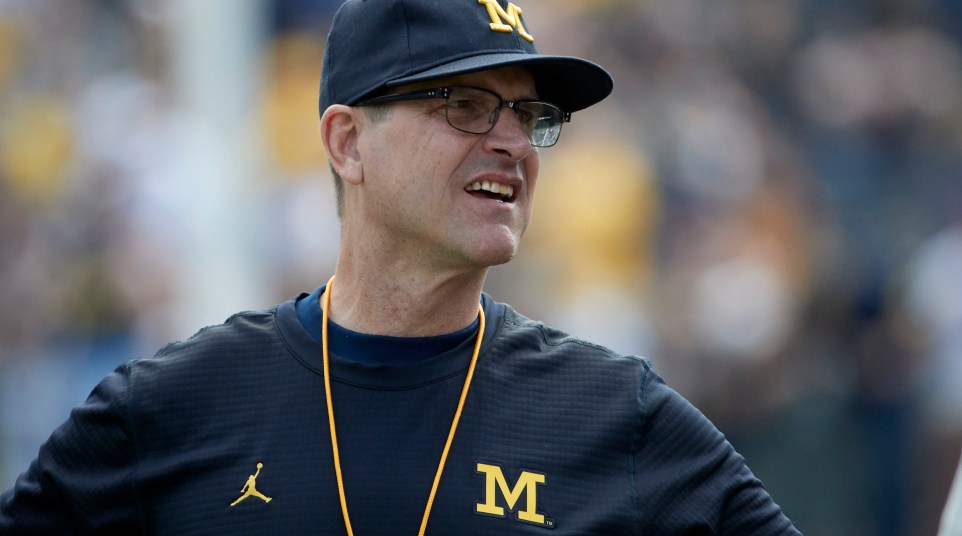
Jim Harbaugh's locker room rant isn't about player safety. It's about his discomfort
Jim Harbaugh did it again. The Michigan head coach wielded his sword and shield and transformed into the crusader for player safety and well-being. This time, at Purdue’s expense.
Full disclaimer: player safety is the single-most important concern in college football, and for good reason. The future of the sport depends on minimizing the risks of serious injury and improving the well-being of the player involved. Nobody should take that lightly.
But when it comes to Harbaugh, I can’t help but shake my head when he throws around the term “player safety.” More on that later.
Back in Ann Arbor after a satisfying 28-10 win over a surging Purdue team, Harbaugh addressed the media on Monday, just as he does every week during the season. He touched on a variety of topics during that press conference, but only one topic really stuck; the outdated and unsanitary state of the visiting locker rooms at Ross-Ade Stadium.
Harbaugh’s words, not mine.
“It didn’t seem sanitary,” Harbaugh said. “And it seems to be a conscious effort to gamesmanship, getting an advantage over the opponent.
“Injured players that can’t get an X-ray, taken to a student health center in a van. We needed a brace for a player, there wasn’t one at the facility we were taken to. There were a lot of things that need to be addressed.”
Harbaugh also claimed the locker rooms were cramped and felt like a “hot box” due to the excessive heat.
Certainly there’s a lot of fact to what Harbaugh says. It’s no surprise that one of the last college football programs to join the ongoing arms race is passing off a dilapidated shanty as a locker room suitable for a B1G program. That story isn’t a hard one to believe.
Harbaugh also tied the words “unsportsmanlike” and “player safety” into his argument. That’s where the bigger story is, at least that’s one guy’s opinion. Because there’s a big difference between uncomfortable and unsafe.
Was Harbaugh and Michigan uncomfortable on Saturday afternoon as an unusual heat sweltered West Lafayette? Probably so. Was it uncomfortable to be crammed into a small brick chamber, standing shoulder-to-shoulder? I’m sure it was. And it was certainly inconvenient to have Wilton Speight travel a few blocks from the stadium to have further examinations done to make sure he wasn’t seriously injured.
Unsportsmanlike? Unsafe? We’re still a long way from hitting those definitions. And how do I — someone who wasn’t in that locker room on Saturday afternoon — know that?
Let’s start with the Michigan football staffer mentioned in Purdue’s response to Harbaugh, an unnamed individual who made the trip to West Lafayette in July, who completed a facilities “walk-thru” and didn’t raise any questions or concerns. If there were serious issues with the accommodations, wouldn’t that staffer have mentioned it back then?
And, if the situation at Purdue was so bad and in such dire need of refurbishment and improvement, why hasn’t it been addressed before? It’s not as if those locker rooms transformed from a luxurious Hampton-like suite into an overflowing outhouse overnight. Major programs, and influential head coaches — Urban Meyer, Frank Beamer, Kirk Ferentz and P.J. Fleck — all dealt with the same situation within the last five years. Speight isn’t the only player from an opposing team to suffer a significant injury at Ross-Ade Stadium.
Even during Tuesday’s B1G teleconference, several head coaches somewhat dismissed the question.
Wisconsin head coach Paul Chryst said “the ones you win in are good, the ones you lose in are bad,” on Tuesday. Nebraska’s Mike Riley said there’s major differences each place you go but he “hasn’t really thought about it.” Both have made the trip to Purdue in the past two seasons.
It’s become a cultural norm in college football. Locker rooms aren’t typically too accommodating and comfortable for visiting teams, regardless of venue. Everyone just went along with that. And then Harbaugh stepped in, advocating for player well-being again.
And why not? It helped him keep satellite camps open and take his team to Europe this past spring. Slap those labels on anything and it immediately becomes a priority for the brass of college football.
Now, according to Harbaugh, it’s going to be an agenda item at B1G meetings. There could be a new standard set for visiting locker rooms, and teams could be forced to dump a significant portion of their revenue into upgrading a facilities that are used seven or eight Saturdays during a calendar year. For places like Purdue, that doesn’t feel like a fair deal.
For places like Michigan — and Ohio State, since Urban Meyer agreed with Harbaugh — some simple upgrades to its facilities for opponents isn’t a huge investment. It’s pocket change for one of the biggest brands in college football. At Purdue — or Northwestern, Indiana, Minnesota, etc. — that revenue is essential to improving and revamping its own facilities and staying competitive in this market.
Providing Harbaugh with a mini-fridge for his whole milk and peanuts isn’t Purdue’s priority. Especially when leap years are nearly as frequent as Michigan’s visits to Ross-Ade Stadium.
If player safety was a serious concern, Harbaugh wouldn’t have been the first to make a comment on the situation he endured on Saturday. And other coaches — particularly those in the B1G West — wouldn’t have glossed over the question about whether an upgrade was necessary.
Harbaugh doesn’t like discomfort. Michigan was probably uncomfortable on Saturday. But his comfort isn’t Purdue’s concern.
It shouldn’t be the B1G’s, either.


